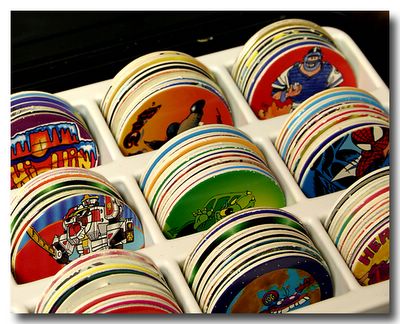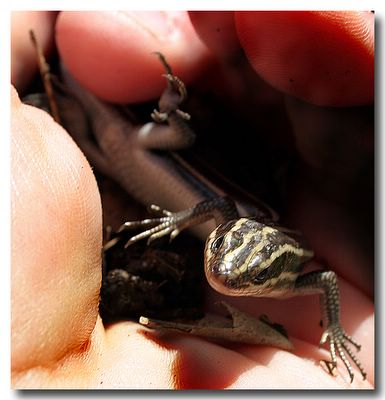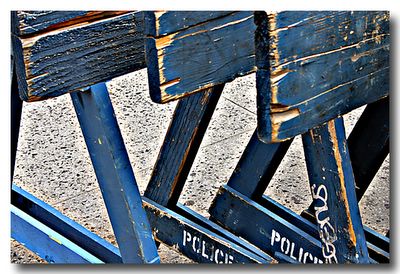Thursday, April 21, 2005
Smooth... Textured
I've been going back through some older photos, many taken with my first digital camera, a Canon A40 2MP point-and-shoot.
When I got the A40 around Labor Day 2002, it was at my wife's suggestion. She wanted a digital camera for family photos and to record her pre-Kindergarten class. I thought it would be cool to have to take photos for selling stuff on eBay, but not much more than that.
At the time, I was going through my born-again-photographer phase, and having grown up 30 years earlier, photographically speaking, with film and metal, mechanical, manual cameras, digital and Wunderplastik just didn't appeal to me.
How wrong I was! I found that the A40 was not just a good, but a great tool with which to make my artsy-fartsy photos. Being able to see the results immediately, at least on a small scale, is a great advantage, I found. You are much more quickly able to absorb what works and doesn't work.
Here are two images that seem to work. The first one is from my Cousin Karen's deck . I like the curve of the chair, echoed by its shadow, and the arc of the table rim, repeated by the glowing shadow cast on the chair.

Cousin Karen's Deck July 2003 Canon A40
Here's another one of my photos from Lee Airport, the little airstrip that could. This is a vintage Taylorcraft, shooting downward through one set of wing struts. I like the combination of the straight diagonals with the teardrop shape of the wheel pants. The bold colors on a neutral background and the raindrops left from the storm 15 minutes earlier are nice touches, I think.

Abstract Taylorcraft May 2003 Canon A40
One thing I noticed that both images share is the contrast of smooth surfaces against textured ones. In the table-and-chair photo, the smooth white plastic of the chair contrasts with the textured glass table top. For the Taylorcraft photo, the aerodynamically smooth aircraft surfaces contrast with the rough texture of the parking apron.
The smooth-textured thing seems to be another one of those patterns that the photo-lobe of my brain seems to like.
When I got the A40 around Labor Day 2002, it was at my wife's suggestion. She wanted a digital camera for family photos and to record her pre-Kindergarten class. I thought it would be cool to have to take photos for selling stuff on eBay, but not much more than that.
At the time, I was going through my born-again-photographer phase, and having grown up 30 years earlier, photographically speaking, with film and metal, mechanical, manual cameras, digital and Wunderplastik just didn't appeal to me.
How wrong I was! I found that the A40 was not just a good, but a great tool with which to make my artsy-fartsy photos. Being able to see the results immediately, at least on a small scale, is a great advantage, I found. You are much more quickly able to absorb what works and doesn't work.
Here are two images that seem to work. The first one is from my Cousin Karen's deck . I like the curve of the chair, echoed by its shadow, and the arc of the table rim, repeated by the glowing shadow cast on the chair.

Cousin Karen's Deck July 2003 Canon A40

Here's another one of my photos from Lee Airport, the little airstrip that could. This is a vintage Taylorcraft, shooting downward through one set of wing struts. I like the combination of the straight diagonals with the teardrop shape of the wheel pants. The bold colors on a neutral background and the raindrops left from the storm 15 minutes earlier are nice touches, I think.

Abstract Taylorcraft May 2003 Canon A40

One thing I noticed that both images share is the contrast of smooth surfaces against textured ones. In the table-and-chair photo, the smooth white plastic of the chair contrasts with the textured glass table top. For the Taylorcraft photo, the aerodynamically smooth aircraft surfaces contrast with the rough texture of the parking apron.
The smooth-textured thing seems to be another one of those patterns that the photo-lobe of my brain seems to like.
Wednesday, April 20, 2005
POGs
We've all been trying to de-junk the house lately, and as usual, Sandy has been doing more than her share. Yesterday, next to the chair she likes to sit in as she goes through old boxes, was a small black plastic box, something about the size of a hardcover book.
I opened the box and found a set of Pogs! When I saw these colorful reminders of the early '90s in their little white slots within the black box, I thought a photo would be in order before they get tossed.

POGs!
For those of you who didn't have young children in the early 1990's, Pogs was a fad that came and went over a period of a few years. It was a game and a collecting hobby wrapped in one.
I had to refresh my memory as to what they were all about - I remembered something about milk bottle caps from Hawaii, but not much more. The Bad Fads Museum website has a good writeup on Pogs, and while you're there, you'll enjoy reading about other fads, from flashes-in-the-pan like Pet Rocks to classics such as Frisbees.
Hey - did anyone see where I put my Three Dog Night 8-track tape??
I opened the box and found a set of Pogs! When I saw these colorful reminders of the early '90s in their little white slots within the black box, I thought a photo would be in order before they get tossed.

POGs!

For those of you who didn't have young children in the early 1990's, Pogs was a fad that came and went over a period of a few years. It was a game and a collecting hobby wrapped in one.
I had to refresh my memory as to what they were all about - I remembered something about milk bottle caps from Hawaii, but not much more. The Bad Fads Museum website has a good writeup on Pogs, and while you're there, you'll enjoy reading about other fads, from flashes-in-the-pan like Pet Rocks to classics such as Frisbees.
Hey - did anyone see where I put my Three Dog Night 8-track tape??
Sunday, April 17, 2005
Skinky Pays a Vist
Sometimes even a mundane chore turns out good.
I went out this morning to do some belated raking and disposing of leaves(belated, as in should have been done before last November.) As I was cleaning the damp leaf litter away from a retaining wall, I saw what looked like a small, flourescent-blue snake qickly slither away.
I bent down to brush aside some more leaf litter and caught a beautiful Five-Lined Skink, Eumeces fasciatus. I've seen these guys scurry in and out of cracks in the retaining wall for years, but I've never been fast enough to catch one.

Eumeces fasciatus
Skinky, out for a walk
Isn't he a beauty? This picture shows off his handsome face and elegant "fingers," but unfortunately, I didn't get a good photo of his amazing blue tail before he managed to wiggle free.
Via the Internet, I learned that Skinky belongs to the only type of skink found in Maryland. In the United States as a whole, there are 15 species, and worldwide, 1280. You can find skinks on every continent except Antarctica.
By the way, please don't confuse skink-y with stink-y! "Skink" comes from the Greek skinkos, meaning lizard, while "stink" comes from the German stinken, which means... well, I don't have to spell it out, do I? In any event, Skinky wasn't at all stinky.
I went out this morning to do some belated raking and disposing of leaves(belated, as in should have been done before last November.) As I was cleaning the damp leaf litter away from a retaining wall, I saw what looked like a small, flourescent-blue snake qickly slither away.
I bent down to brush aside some more leaf litter and caught a beautiful Five-Lined Skink, Eumeces fasciatus. I've seen these guys scurry in and out of cracks in the retaining wall for years, but I've never been fast enough to catch one.

Eumeces fasciatus
Skinky, out for a walk

Isn't he a beauty? This picture shows off his handsome face and elegant "fingers," but unfortunately, I didn't get a good photo of his amazing blue tail before he managed to wiggle free.
Via the Internet, I learned that Skinky belongs to the only type of skink found in Maryland. In the United States as a whole, there are 15 species, and worldwide, 1280. You can find skinks on every continent except Antarctica.
By the way, please don't confuse skink-y with stink-y! "Skink" comes from the Greek skinkos, meaning lizard, while "stink" comes from the German stinken, which means... well, I don't have to spell it out, do I? In any event, Skinky wasn't at all stinky.








